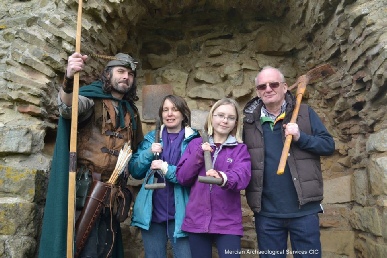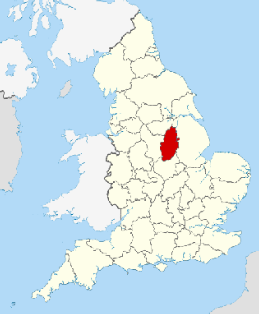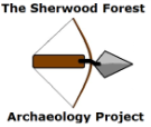
The ethos and aims of the Sherwood Forest Archaeology Project:
The Sherwood Forest Archaeology Project has the tag-
The Sherwood Forest Archaeology project is a Community Archaeology project-
The project is designed to bring sustainability to archaeological projects and investigations in Sherwood Forest by combining a number of funding streams including private, corporate, public and crowd-
The project aims to undertake long-
The project also seeks to be a free resource, where all research and fieldwork are available to the community at large, to foster a greater understanding of the heritage of Sherwood Forest.
The project aims to promote the notion of a wider Sherwood Forest that stretches across the multitude of sites that link together to make up this unique and exciting landscape.
The Project engages people from all walks of life and ages; including adults with learning difficulties, young people, as well as those currently out of work desiring transferable skills, students needing experience, and volunteers... in this landscape of legends and folklore... all overseen by professional community archaeologists.
The project aims to research the Sherwood Forest area from the prehistoric to the present day.
From prehistoric activity, Roman villas and field-
The Sherwood Forest Archaeology Project seeks to discover, record, and interpret the archaeology of the Forest as a whole, and to promote it through public involvement; to a local, regional, national and global audience, and therefore help to protect it and preserve it for future generations.
The project consists of many individual research topics across the Sherwood Forest area, and combines these into one overall long-
This project is the first time Sherwood Forest as a whole has been subject to a landscape-
Community Benefits:
The project aims to help communities to engage in their heritage, and is underpinned by a strong belief in the power of the narrative of that heritage; in bringing about social cohesion, and a sense of place and belonging.
The project also seeks to bring increased value to the landscape of the forest through a better understanding of the heritage of that landscape; through the direct involvement of the community in the research, and through the sharing of that new knowledge with the wider world.
The project seeks to bring investment into Sherwood Forest, directly to the project, but also through increased foot-
Internet and social media output is designed to share knowledge but to also promote the landscape of the forest to a global audience, which we hope will result in all the benefits to the community brought about by a raising of its profile.
The project seeks to foster a wider appreciation of the heritage and landscape of Sherwood Forest in order to promote better management of the landscape and heritage, and also to encourage tourism.
The project believes in fostering connections between businesses and groups to create networks that are powerful and sustainable, which can bring about genuine change in the area.
and at the Facebook page : www.facebook.com/sherwoodforesthistory (around 5,000 followers).
The Sherwood Forest Archaeology Project is currently developing and funding many projects across the forest area including Clipstone Peel, St Edwin's Chapel, King John's Palace, Clipstone, Edwinstowe,Thynghowe, the Sherwood Forest National Nature Reserve and others.
The project has also undertaken many phases of work in Kings Clipstone and King John's Palace.
The project provides support to the work of community groups in Sherwood Forest by provide access to experts on the archaeology of the forest.
The project archaeologists can offer archaeological consultancy to groups.
The project also supports the work undertaken by groups in the forest and promotes this via websites and social media top a global audience.
Archaeological Benefits:
The project aims to undertake long-
The project and individual sub-
The project is designed to form part of a new Post-
The project aims to employ archaeologists to undertake investigations to the highest possible standards and for the purposes of research-
The project puts research back at the fore-
Undertaking projects based on research means that sites that have and will not be looked at in the planning system can receive the attention they deserve.
The project seeks to raise standards in archaeological investigations and recording and dissemination in the area.
All archaeological works are carried out to the standards and guidance of the Institute for Archaeologists.
The project offers training and work experience opportunities to archaeology students and post-
The project employs archaeological specialists from ceramics, environmental sciences, geologists, geophysicists, forensics, metalwork, bones (animal and human), and utilises academics and professionals to provide work for others in the industry and to provide the highest quality research.
All finished reports are submitted with the local authority Historic Environment Records office.
All reports are available for download from Mercian Archaeological Services CIC.
Oasis entries are made for all reports
Project Study Area:
Sherwood Forest is located entirely within Nottinghamshire, a county located almost directly in the centre of England in the English East Midlands.

Map: Location of Nottinghamshire. This file is licensed under the Creative Commons Attribution-
The project mainly focuses within the boundaries of Sherwood Forest from the early 12th century and 13th century Forest as shown in the map to the right.
The earliest boundary of Sherwood Forest in the records come from 1156 but refers to the boundaries of the forest in circa 1100.
This area includes all of that highlighted in mid-
This area includes all of the Sherwood Sandstone formation and includes the whole of the Hatfield division of the ancient Wapentake of Bassetlaw (see Battle of Hatfield for more details).
During the time of Henry II (1154-
Following magna Carta (1215) and the subsequent Forest Charter (1217) the area of Forest in Nottinghamshire was reduced to that shown in dark-
The first perambulation defining the boundary of the Forest was in 1218 and subsequent perambulations through the 13th century resulted in the 13th century boundary as depicted on the ma, confirmed by Edward I in the year 1300.
Map: Boundaries of Sherwood Forest
© Mercian Archaeological Services CIC, 2018.

The oldest documented mention of a 'Sherwood Forest' comes from a charter dating from 958AD granting Scrooby and Sutton cum Lound in north Nottinghamshire from the Crown to the Archbishop of York. This charter lists a 'Scirwuda' (Shire Wood) as a boundary mark of the land granted to the Archbishop.
Scirwuda was on the western edge of the these landholdings adjacent to Barnby Moor on the edge of the Sherwood Sandtstones.
This places Scirwuda as mentioned in 958 in the location of the boundary from the early 12th century and could support this not only being the original boundary of Sherwood Forest, but could also suggest there was a Sherwood Forest or ‘Shire Wood’ in this vicinity in Saxon times.
Scrooby was later the home of William Brewster and is one of the sites associated with the Mayflower Pilgrims. The Archbishop of York built a residence there in medieval times which was used by the separatists in the early 17th century.
Project page links:
-
-
-
-
-
-
-
-
The Sherwood Forest
National Nature Reserve Archaeology Survey
-
Long term Research at
King John’s Palace:
Ancient Royal Heart of Sherwood Forest
-
The Sherwood Forest Archaeology Training Fieldschool
-
“Scirwuda-
Ghost and Shadow woods of Sherwood Forest Project
-
Investigating Thynghowe Viking
Meeting Site
-
Searching for the
The Battle of Hatfield
-
-
Fieldswork at St Edwin’s Chapel
-
St Mary’s Norton-
-
Mapping Medieval Sherwood Forest
-
The Sherwood Forest LiDAR
Project
-
Warsop Old Hall
Archaeological Project
-
The Sherwood Villages Project:
Settlement Development in the Forest
-
-
-
Researching Edward IIs fortification at Clipstone Peel
-
-
-
-
The Cistercians of Rufford Project:
Settlement Development, Dynamics and Desertion.
-
Sherwood Forest Environmental Survey
-
World War II in Sherwood Forest -
-
World War I in Sherwood Forest -
-
About Medieval Sherwood Forest
-
Robin Hood and Sherwood Forest
-
-
-
-
-
-
-
-
-
-
-
-
Project page links:
-
-
-
-
-
-
-
-
The Sherwood Forest
National Nature Reserve Archaeology Survey
-
Long term Research at
King John’s Palace:
Ancient Royal Heart of Sherwood Forest
-
The Sherwood Forest Archaeology Training Fieldschool
-
“Scirwuda-
Ghost and Shadow woods of Sherwood Forest Project
-
Investigating Thynghowe Viking
Meeting Site
-
Searching for the
The Battle of Hatfield
-
-
Fieldswork at St Edwin’s Chapel
-
St Mary’s Norton-
-
Mapping Medieval Sherwood Forest
-
The Sherwood Forest LiDAR
Project
-
Warsop Old Hall
Archaeological Project
-
The Sherwood Villages Project:
Settlement Development in the Forest
-
-
-
Researching Edward IIs fortification at Clipstone Peel
-
-
-
-
The Cistercians of Rufford Project:
Settlement Development, Dynamics and Desertion.
-
Sherwood Forest Environmental Survey
-
World War II in Sherwood Forest -
-
World War I in Sherwood Forest -
-
About Medieval Sherwood Forest
-
Robin Hood and Sherwood Forest
-
-
-
-
-
-
-
-
-
-
-
-
Community Archaeology in Derbyshire
Community Archaeology in Leicestershire
Community Archaeology Nottinghamshire, Excavation, Research, Volunteering, Community Archaeology Derbyshire, Training, Social, Learning, Community Archaeology Leicestershire, Heritage, Involvement, Belonging, Knowledge sharing, Community Archaeology Lincolnshire, Topographic Survey, Talks and Presentations, Outreach, Archaeology Projects , Open Days, Schools, Finds Processing, Day Schools, Field Schools, Young People, Archaeology and History of Sherwood Forest, Pottery Research, Medieval, Roman, Prehistoric, Community Interest Company, Community Archaeology Nottinghamshire.
Community Archaeology in Nottinghamshire
Community Archaeology East Midlands
Community Archaeology in Lincolnshire
Community Archaeology in Yorkshire
Mercian Archaeological Services CIC
Specialists in Community Archaeology, Public Involvement, Research & Training
© Mercian Archaeological Services CIC 2024. Registered Business No. 08347842. All Rights Reserved.






The Future of Sherwood’s Past




Community Archaeology Nottinghamshire, Community Archaeology Derbyshire, Community Archaeology Leicestershire, Community Archaeology East Midlands, Mercian Archaeological Services Community Archaeology for Nottinghamshire, Derbyshire, Sherwood Forest, Leicestershire and the East Midlands. Community Archaeology Nottinghamshire, Community Archaeology East Midlands, Community Archaeology Leicestershire. Archaeological
About -
